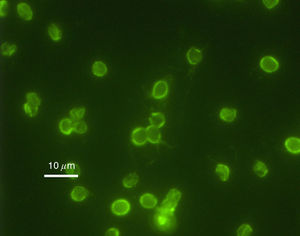Shock chlorination: Difference between revisions
From MicrobeWiki, the student-edited microbiology resource
| Line 24: | Line 24: | ||
==Conclusion== | ==Conclusion== | ||
Overall text length should be at least 1,000 words (before counting references), with at least 2 images. Include at least 5 references under Reference section. | Overall text length should be at least 1,000 words (before counting references), with at least 2 images. Include at least 5 references under Reference section. | ||
==References== | ==References== | ||
Revision as of 01:00, 4 November 2013
Introduction
From swimming pools to wells, chlorine is a common chemical used to disinfect water sources.
Microbial agents
Helicobacter pylori

Electron micrograph of Helicobacter pylori, a microbe commonly found in public water sources. Courtesy: Timothy Hoover (Franklin College)
Cryptosporidium

Immunofluorescence of Cryptosporidium, the microbe that caused an epidemic in Milwaukee in 1993. Over 104 deaths were credited to the waterborne microbe . Courtesy: H.D.A Lindquist (EPA)
Methods
Success rates
Alternative methods
Conclusion
Overall text length should be at least 1,000 words (before counting references), with at least 2 images. Include at least 5 references under Reference section.
References
Edited by Erika Jensen, student of Joan Slonczewski for BIOL 116 Information in Living Systems, 2013, Kenyon College.
